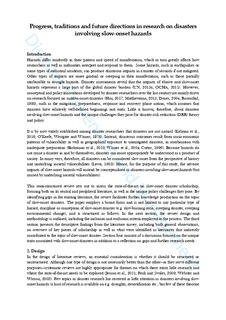| dc.date.accessioned | 2020-01-29T13:50:51Z | |
| dc.date.available | 2020-01-29T13:50:51Z | |
| dc.date.created | 2019-04-19T10:16:05Z | |
| dc.date.issued | 2019-10 | |
| dc.identifier.citation | Staupe-Delgado, R. (2019) Progress, traditions and future directions in research on disasters involving slow-onset hazards. Disaster Prevention and Management, 28(5), pp. 623-635. | nb_NO |
| dc.identifier.issn | 0965-3562 | |
| dc.identifier.uri | http://hdl.handle.net/11250/2638643 | |
| dc.description.abstract | Purpose
The importance of onset speed has been stressed by disaster researchers and inter-governmental bodies for some time, but its meaning and knowledge frontier has not been explored in depth. The purpose of this paper is to contextualise disasters involving slow-onset hazards within the broader literature on disasters, assess the current state of knowledge and identify themes in the literature.
Design/methodology/approach
This paper employs a semi-structured review design with the purpose of identifying both scholarship engaging directly with the term and less obvious but related literatures.
Findings
The majority of publications that mention slow-onset hazards and their adverse impacts do so only by means of delimitation. The paper finds that there is a great need for empirical and theoretical work on onset and manifestation speed and to test the degree to which existing theories and frameworks of disaster management are also relevant for the study of slow-onset hazard impacts.
Research limitations/implications
The review identifies several gaps in existing research disasters involving slow-onset hazards and proposes research on community, political, policy and practical challenges, including answering the question of how to secure proactive response to emerging slow-onset hazard impacts.
Practical implications
In theory, hazards with a gradual and creeping onset are easier to manage and proactively respond to than that of sudden and unexpected ones. Not only do slow-onset hazards provide more lead time, but also a larger potential for proactive response, which in turn provides ample time to take early action to cushion their impacts. Yet, warnings often go unheard and response is put on hold until impacts become unnecessarily costly to reverse. More research on onset speed and gradual manifestation patterns should therefore be carried out.
Originality/value
Gradually occurring hazards have remained largely absent from the core literature on disasters, including most definitions of the term. This paper represents an initial effort to assess the state-of-the-art on the concept and the phenomenon of disasters involving slow-onset hazards. | nb_NO |
| dc.language.iso | eng | nb_NO |
| dc.publisher | Emerald Publishing Limited | nb_NO |
| dc.subject | samfunnssikkerhet | nb_NO |
| dc.subject | hazard management | nb_NO |
| dc.subject | klimaendringer | nb_NO |
| dc.subject | resiliens | nb_NO |
| dc.subject | climate change | nb_NO |
| dc.title | Progress, traditions and future directions in research on disasters involving slow-onset hazards | nb_NO |
| dc.type | Journal article | nb_NO |
| dc.type | Peer reviewed | nb_NO |
| dc.description.version | acceptedVersion | nb_NO |
| dc.rights.holder | Copyright © 2019, Emerald Publishing Limited | nb_NO |
| dc.source.pagenumber | 623-635 | nb_NO |
| dc.source.volume | 28 | nb_NO |
| dc.source.journal | Disaster Prevention and Management | nb_NO |
| dc.source.issue | 5 | nb_NO |
| dc.identifier.doi | 10.1108/DPM-11-2018-0358 | |
| dc.identifier.cristin | 1693189 | |
| cristin.unitcode | 217,8,3,0 | |
| cristin.unitname | Institutt for sikkerhet, økonomi og planlegging | |
| cristin.ispublished | true | |
| cristin.fulltext | postprint | |
| cristin.qualitycode | 1 | |
